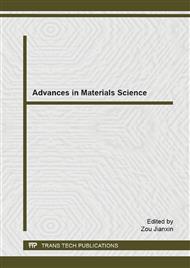[1]
R. R. Archer, in: On the distribution of the tree growth stresses, Wood Sci. Technol. Vol. 13 (1979), pp.67-78.
Google Scholar
[2]
R.R. Archer, in: On the origin of growth stresses in trees part I. micro mechanics of the developing cambial cell wall, Wood Sci. Technol. Vol. 21 (1987), pp.139-154.
DOI: 10.1007/bf00376194
Google Scholar
[3]
R.R. Archer, in: On the origin of growth stresses in trees part II. Stresses generated in a tissue of developing cells, Wood Sci. Technol. Vol. 23 (1989), pp.311-322.
DOI: 10.1007/bf00353247
Google Scholar
[4]
S. Ormarsson, O. Dahlblom, M. Johansson, in: Finite element study of growth stress formations in wood and related distortion of sawn timber, Wood Sci. Technol. Vol. 43 (2009), pp.387-403.
DOI: 10.1007/s00226-008-0209-2
Google Scholar
[5]
A. Teischinger, in: The development of wood Technology and Technology developments in the wood industries from history to furniture, Eur. J. Wood Prod. Vol. 68 (2010), pp.281-287.
DOI: 10.1007/s00107-010-0458-2
Google Scholar
[6]
B. Esteves, A.V. Marques, I. Domingos, H. Pereira, in: Influence of steam heating on the properties of pine (Pinus pinaster) and euclaypt (Eucalyptus globulus) wood, Wood Sci Technol. Vol. 41 (2007), pp.193-207.
DOI: 10.1007/s00226-006-0099-0
Google Scholar
[7]
P. Nzokou, J. Zyskowski, S. Boury, D.P. Kamdem, in: Natural decay resistance of LVL made ov neneers from durable and non-durable wood speceis, Eur. J. Wood Prod. Vol. 63 (2005), pp.173-178.
DOI: 10.1007/s00107-004-0548-0
Google Scholar
[8]
F. Scholz, J. Ratnasingam, in: Characterizing surface defects in machine-planing of rubberwood (Hevea brasiliensis), Eur. J. Wood Prod. Vol. 65 ( 2007), pp.83-87.
DOI: 10.1007/s00107-006-0163-3
Google Scholar
[9]
L. Gurau, H. Mansfield-Williams, M. Irle, in: Processing roughness of sanded wood surfaces, Eur. J. Wood Prod. Vol. 63 (2005), pp.23-52.
DOI: 10.1007/s00107-004-0524-8
Google Scholar
[10]
G. Goli, M. Fioravanti, R. Marchal, L. Uzielli, in: Upmilling and down-milling wood with different grain orientations – Theoretical background and general appearance of the chips, Eur. J. Wood Prod. Vol. 67 (2009), pp.257-263.
DOI: 10.1007/s00107-009-0323-3
Google Scholar
[11]
P.L. Tan, S. Sharif, I. Sudin, in: Roughness models for sanded wood surfaces, Wood Sci. Technol. DOI 10. 1007/s00226-010-0382-y (2010).
DOI: 10.1007/s00226-010-0382-y
Google Scholar
[12]
J. Palmqvist, M. Lenner, S. I. Gustafsson, in: Cutting-forces when up-milling inbeech, Wood Sci. Technol. Vol. 39 (2005), pp.674-684.
DOI: 10.1007/s00226-005-0010-4
Google Scholar
[13]
J. Smardezewski, in: Technological heterogeneity fo adhesive bonds in wood joints, Wood Sci Technol. Vol. 36 (2002), pp.213-227.
DOI: 10.1007/s00226-002-0127-7
Google Scholar
[14]
D. Minelga, V. Norvydas, in: Properties of halogensilane Modified Poly(viney acetate) Dispersion, Materials Science ( medziagotyra) Vol. 11, (2005) pp.146-149.
Google Scholar
[15]
J. Follrich, A. Teishinger, W. Gindl, U. Mller, in: Effect of grains angle on shear strength of glued end grain joints of defect-free softwood timber, Wood Sci. Technol. Vol. 41 (2007), pp.501-509.
DOI: 10.1007/s00226-007-0136-7
Google Scholar
[16]
J. Follrich, O. Vay, S. Veigel, U. Mller, in: Bond Strength of end-grain joints and its dependence on surface roughness and adhesive spread, J. Wood Sci. Vol. 56 (2010), pp.429-434.
DOI: 10.1007/s10086-010-1118-1
Google Scholar
[17]
A.W. Ballarin, M. Nogueira, in: Caracterização Elástica da Madeira de Eucalyptus citriodora, CERNE, Vol. 9 (2003), pp.66-80.
Google Scholar
[18]
Associação Brasileira de Normas Técnicas - ABNT NBR 7190 (1997) Design of wooden structures. ABNT, Rio Janeiro.
Google Scholar
[19]
M. Mendoza, P. Hass, F.K. Wittel, P. Niemz, H.J. Herrmann, in: Adhesive penetration of hardwood: a generic penetration model, Wood Sci. Technol., (2010) DOI 10. 1007/s00226-011-0422-2.
DOI: 10.1007/s00226-011-0422-2
Google Scholar


